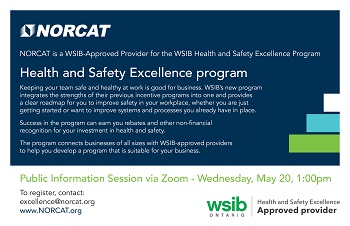 |
||||||||||||||||||||||||||||||||||||||
|
||||||||||||||||||||||||||||||||||||||
|
This week, the construction sector returned to work. All ICI contractors are now able to begin recovering from the significant economic and financial impact of being closed for six weeks. The remobilization of the construction industry is a significant victory for our members, and we hope that all contractors return to work safely and with only minor delays. This reopening was only possible due to the tireless advocacy by your Government Relations staff at the OGCA. Together with our allies in the design and construction industry, we were able to provide conclusive evidence from the WSIB that ICI worksites were safe and ready to get back to work. However, we are by no means close to “normal.” The new “COVID normal” will put further emphasis and pressure on health and safety in the construction sector. Should infection rates increase and sites become infected, our industry would be subject to heighten scrutiny and shut down without hesitation. As contractors, we need to double our efforts in making sure that ICI worksites are the safest in Ontario, and be at the epicentre for health and safety innovation. Throughout the pandemic, we have been working closely with the IHSA and the Chief Prevention Officerto create practical guidelines that will protect workers and work on construction projects. PPE solutions are also available. You can find a list of Health Canada approved products here. The OGCA is also reviewing PPE suppliers and will be providing a list on our website shortly. As we get a better understanding of the actual economic impact of COVID-19, the remobilization of the construction industry has already been seen as a useful tool for economic recovery. In this time of recovery, the OGCA will shift focus to advocacy on other issues caused by the pandemic, such as its impact on delay claims, contract relief, the labour pool and supply chain. For more information about the economic impact of COVID-19, health and safety information and other topics related to ICI contracting in Ontario, please visit www.ogca.ca.
The OGCA has partnered with the Ontario Chamber of Commerce and other associations to commission two polls: one of the public and the other of businesses (to be available in a few days). You can find a presentation with the results here.
The first poll, focused on the public, clearly shows that the Ontario public's financial security had been rocked. Evidence shows that 31% are concerned with their ability to pay their bills, and 36% are concerned about their jobs. These results speak to an environment of instability and a massive impact on the consumer's ability to support our economy. The poll also considered the role of government and employees in starting up business in a manner that protects employees and customers. When asked, 60% of responders expressed confidence that those employed in small businesses are properly trained to keep employees and customers safe.
When asked about the role of government, 82% of responses agreed that it has a role in requiring and mandating a "Workplace COVID-19 safety and training program that all employees must complete." There obviously will be a high demand for business and government to work hand in hand to keep workplaces safe.
Industry News
This document is issued jointly by the Ontario Association of Architects (OAA) and the Ontario General Contractors Association (OGCA). It provides information relative to best practice regarding the publication of Certificates of Substantial Performance (CSPs). Please click here to open the document. The WSIB is pleased to announce that Elizabeth Witmer has been re-appointed for a third term as Chair of the Board of Directors – a position she has filled with distinction since 2012. Mrs. Witmer’s reappointment is effective May 17, 2020 to December 31, 2020. Under Mrs. Witmer’s exceptional leadership the WSIB has been successful in achieving key milestones, including declining premium rates, the elimination of the WSIB’s historic unfunded liability, the introduction of our new premium rate-setting model, the creation of our new Health and Safety Excellence Program, and the expansion of our online services. Mrs. Witmer has been recognized on many occasions for her passionate advocacy and long-term commitment to workplace health and safety and most recently by the Ontario General Contractors Association who presented her with the Doug Chalmers Award for Safety during her years of public service Mrs. Witmer has also received numerous honours including the Queen’s Golden and Diamond Jubilee Medals, the Social Work Doctors’ Award, was named an Honorary Nurse by the RNAO and received the KW Citizen of the Year Award. "Over her distinguished career, Elizabeth Witmer has demonstrated strong leadership and a commitment to public service," said Monte McNaughton, Minister of Labour, Training and Skills Development. "I am grateful she has agreed to continue her work at the WSIB, particularly during this critical time for worker safety." We at the WSIB are grateful for Mrs. Witmer’s continued leadership as we look forward to building on our recent accomplishments and continue our momentum as we seek to deliver better results for the people we serve.
You are faced with the challenge of returning your employees safely to the job site, and keeping them safe so we do not need to experience another shutdown of our industry. Tomorrow, Thursday, May 21, from 3:30 to 4:45 p.m., our webinar will be focused on getting your workers “Back to Work.” Re-Mobilizing: Are you ready? Many tradespeople are both eager and anxious about returning to work. As leaders, we need to ask ourselves, “are we ready to receive them?” This session will focus on some human factors to consider to ensure a smooth and safe transition back. Our presenters will include: Norm Keith, Partner with Fasken. Norm is one of the top workplace health and safety lawyers in Canada. He will present on returning your workers safely, complying with the new workplace guidelines and expectations, and communicating your plans to workers, unions, and inspectors. Robert Love, Director of Safety and Quality with Alberici Constructors. Robert will speak about human factors to consider when re-mobilising your workforce: communicating clear safe work expectations, managing individual anxieties, and heightening presence in the field. Jason Bubba, Director of Training & Development with NORCAT. Jason will discuss how to leverage technology and modern learning techniques to adapt to a new world of training. From safety training, health pre-screening, to on-site compliancy systems, Jason will demonstrate how companies can mitigate risk with a mix of digital tools. Our workers return to a different world requiring physical distancing, cleanliness and tighter procedures. The League of Champions is pleased to support your OH&S needs during the pandemic. Please join us for a discussion about bringing your workers Back to Work. Click here to view the invitation. To register for this FREE webinar, click here. All the webinar presentations are available for you online on the LOC website. League members, safety consultants and government officials have all presented best practices and strategies to keep your members safe with COVID-19. To view all the webinar presentations and watch the recordings, visit the LOC webinar page. April 23 – Sharing Best Practices: COVID-19
May 4 – Supporting Employees Mental Health During COVID-19
May 14 – Reopening the Construction Industry
Member News
In an effort to show our appreciation for front-line site staff and our support for local restaurants struggling in response to COVID-19 restrictions, we issued the #LunchBoxChallenge to the BC construction industry and received an overwhelming response.
Associate Partner News and Events
As the construction industry recovers, construction leaders on the frontlines have to navigate their firms through the pandemic and this difficult time. Join Procore for a free webinar about the challenges our industry is facing and the technology solutions they are implementing to keep safety a priority while ensuring that their teams remain productive, informed and motivated while keeping projects moving. Join Jas Saraw of Procore Technologies on May 21 at 11 AM PST / 2 PM EST as he speaks with the following brilliant leaders: Allan Beron - President of Urban One Builders Panellists will speak to the near-term impacts, and long-term considerations that construction firms need to consider that are impacting operations across the board while providing their perspectives and thoughts on the way forward. It's going to be a good one. Hope to see you there. RSVP required, register here - https://lnkd.in/gGUdewv
NORCAT is an approved provider of the HSEP and provides weekly (every Wednesday) Public Information Sessions to those interested in learning about the Excellence program. Please join us via Zoom. If you missed the May 20 session, please check out the session on May 27. Register below: May 20, 1:00 p.m.: https://norcat.zoom.us/meeting/register/tJEtdOCgqz0uHNPQQYd2_1vlZiw8hkXg8Msi May 27, 1:00 p.m.: https://norcat.zoom.us/meeting/register/tJUuf-utqzIjGdZY1tKkTXUMIOaipOW81AFp It is important to know that by joining the Excellence program, businesses can earn rebates on WSIB premiums and recognition for developing COVID-19 related policies and procedures, and other initiatives to ensure health and safety in their workplace. The table below outlines the HSEP Topics that can be used to address COVID-19 at your workplace:
As government orders are lifted, employers will enter uncharted territory. Sherrard Kuzz LLP has a deep understanding of the pandemic’s impact on businesses and industries, and how to work through the related workplace issues. We are ready to assist clients throughout this process – to develop and implement customized Return to Work (“RTW”) plans, train workplace leaders on how to manage the issues, and audit existing employment agreements and practices to assess whether they should be amended to provide greater flexibility in the event of a future shut-down or slow-down. To help you get started, we have developed the attached Complimentary RTW considerations. Topics include:
We are also hosting a Half-Day Workshop – ABSENTEEISM AND ATTENDANCE ISSUES IN A COVID-19 WORLD, in which participants will acquire knowledge and the tools to effectively and efficiently address a range of absenteeism and attendance issues related to COVID-19. Details, including how to register for this workshop, can be found by clicking here.
Legislative & Legal Updates
In a decision released last week, in addition to providing useful guidance regarding the objectives of the Companies’ Creditors Arrangement Act (CCAA), the Supreme Court of Canada (SCC) approved a litigation funding agreement in an insolvency proceeding. The case could have significant implications for the use of litigation funding in future cases. Click here to read the full update. The latest issue of the Ontario Legislative Reports (May 11, 2020) is now available online at the OGCA website. Please click here to access this report, or to see earlier editions. The Ontario Legislative Report is updated every two weeks and explains the intention and status of legislation and regulations that could impact the construction industry. For issues prior to April 2019, please contact Mary Wademan at OGCA. Education & Events
Healthy communication is one of the most important things you can do to protect and support Mental Health. In this series of articles, I will focus on one aspect of communication with practical suggestions on how to apply it. Part 2 Factors Affecting Communication There are 3 factors affecting how an employee understands you when you talk to them. Each factor is combined with the others automatically as an employee listens to you and affects how you’re understood. Knowing how important each factor is can give you an edge and help you communicate more effectively. Verbal, para-verbal and non-verbal are the three factors that affect how well you communicate, but they are not created equal. What you actually say accounts for 7% of how you’re understood, how you sound while saying it 38% and how you look while saying it 55%. When being supportive with employees pay attention to the tone of your voice and how fast you’re talking. A calm even tone, low voice and a medium to slow talking speed is best to get a supportive message across. You can practice and develop these things like any other skillset. If you’re online, make an effort to look as directly as you can at your webcam. The person then sees you’re making eye contact. It takes practice because we’re often distracted by our own video window. If in person, keep your arms uncrossed and lean forward slightly as a way to show interest and openness. Next week I will discuss the most effective ways to deal with employee fear and anxiety over catching COVID-19 at work. If you have questions, need training or literature please contact Julian directly: Direct Line: 905-866-7301 Jane Snyder, MHNE, RNCP, ROHP, and the Director of Operations/Health and Safety at Snyder Construction, has prepared Lesson 4 - Stress and the Brain. Please click here to read it. |
||||||||||||||||||||||||||||||||||||||

 As of Tuesday, May 19, the whole industry is open for business under COVID-19 conditions.
As of Tuesday, May 19, the whole industry is open for business under COVID-19 conditions.



 The new WSIB Health and Safety Excellence program gives businesses of all shapes and sizes incentive to invest in workplace health and safety.
The new WSIB Health and Safety Excellence program gives businesses of all shapes and sizes incentive to invest in workplace health and safety. 



 By: Julian Toy, H.S.C., Member of The Ontario Association of Mental Health Professionals
By: Julian Toy, H.S.C., Member of The Ontario Association of Mental Health Professionals